Methodologies Sale
Sale of goods in shop
To simplify the creation of documents in K2 IS, the Sale of goods at Store (Prodejka2_Hlavni.pas) tools (script) can be used in the case of retail selling.
Preparation before running the script
Tool (script) for retail selling works especially over the Sales Order module, but it can be also set eg. as a button on the desktop.
Before running the script, it is necessary to set the following:
- Create a customer card in the Suppl./Cust. code list (it will be enough to fill obligatory fields). Use the Number for filling the parameter of the Customer script. For this customer, sale documents (sales orders, invoices out, release notes) will be issued for the anonymous customer in retail selling, if another customer will not be selected.
- According to need and proper application set script´s parameters described in the Sale of Goods at Store script parameters chapter.
- If you want to pay in a foreign currency, it is necessary to set a fixed exchange rate of this currency. This setting is performed by the separate script Retail Sale - Exch. Rates (Prodejka2_Kurzy.PAS). Here you set a cash register for which the rate is valid, and the date from which it is valid.
- The user, who will work with the script, should have set the right to exceeded credit (for cases where at the time of making the business case, the credit is already exceeded and therefore the credit would be exceeded by confirmation of the invoice when payment in cash.
- The user has to set the Price group on item from heading user parameter so that prices of every new item would be loaded correctly.
Sale of Goods at Store script parameters
Before activating the script, it is necessary to set several parameters (such as Book of Sale, the values in a Sales Order, etc.). This setting is made by using parameters. You can influence behaviour of the whole script, fields setting etc. by other parameters. The parameters are roughly described bellow, theirs usage is also described in following chapters in detail.
The script contains these parameters:
BezhotovostniPlatby (cashless Payments) |
List of Payment Methods is set by this parameter. It enables the customers not to pay the business case and to take the Articles "only with Invoice", it means, the Cash payment is not enforced. The listed Payment Methods are separated by semicolon. The list is compared with the contents of the Payment Method field in the Customer card. The value 'Transfer' is set by default. |
FormaObjednavky (Form of Order) |
The contents of the Form of order field in a created Sales Order. The '-' value is set by default. |
KodZakazky (ContractCode) |
The contents of the Contract Code field in a created Sales Order and subsequently in the others generated documents and theirs items. The '-' value is set by default. |
MaximalniCastkaProParagon (Maximal Amount for a Receipt Slip) |
The law restricts the maximal amount of a payment that can be made "on a sales slip", the business cases in a higher value must be invoiced. The printing of a sales slip is disabled when exceeding a specified amount. The value is set on '10000' by default. |
NahrazovatImplCenSK (Supply default price groups) |
If the parameter is filled in by an abbreviation of a Price Group, then the C0 price group (number of the price group = 0), that is inserted according to the value in the Customer card, will be substituted by a price group from the parameter. The empty value is set by default. It means that a price group according to a Customer card remains in the Sales Order. |
NeukladatZakazku (Do Not Save Sales Order) |
Parameter addresses a behaviour when concluding Sales Orders which are in progress. When the value is set on 'false' (it means the default setting), a window to ask for saving a Sales Order will be displayed after pressing Esc key on a Sales Order in process. The value 'true' suppresses this dialog, a Sales Order will not be saved after its closing. |
NevytvaretRezList (Do Not Create Reserving Card) |
The parameter determines, whether a Reserving card will or will not be created after closing a business case in case that it was not possible to create a Release Note, e.g. due to lack of disposal. The 'false' value is set by default, it means that a Reserving Card will be created. |
NevytvaretVydejku (Do Not Create Release Note) |
The parameter defines whether to create a Release Note after closing a business case. The 'false' value is set by default, it means that a Release Note will be created. |
Opakovaný tisk (Repeated print) |
Setting on 'true' enables to print in addition/reprint an already created Invoice or a Receipt Slip according to the identical criteria, according to which the possibility of printing when creating a new business case is evaluated. The buttons for re-print are accessible on the 1st page of a Retail in Browse mode, also by means of hot key. |
Platba (Payment) |
The automatic setting of the choice, whether a business case will be paid in cash or whether it is invoiced (it means the payment will not be required). If it is necessary, this setting may be operatively changed in the Payment form, if other circumstances permit it. The value '0' is set by default, it means the payment in cash; the value '1' would mean the invoicing. |
PlatbaFakturovat (PaymentInvoice) |
A Payment method is set by this parameter. This Payment Method will be set into a Sales Order if the user selects the Invoice option in the Payments form. The "Transfer" value is set by default. |
PlatbaHotove (PaymentInCash) |
A Payment Method which has been set by this parameter is set into a document if the amount, which should be refunded to a customer, is automatically deducted. The "In Cash" value is set by default. |
PlatbaVProhlizeni (PaymentInBrowseMode) |
True = the Pay button is accessible also in Browse mode. |
Pokladna1 (CashRegister1) |
Setting of a Cash Registers book which will be used for payments. The "HL" value is set by default. |
Pokladna2 - 7 (CashRegister2 - 7) |
Setting of the Cash Registers books which will be used for payments. The values '' are set by default. |
PosledniPole (LastField) |
The last field when controlling the form by using keys. After leaving the field which is set by this parameter, by pressing Enter key an entering item will be inserted and the form will be prepared to insert a new item. The 'xESleva' value is set by default. |
Rada (Book) |
Into which book the Sales order will be created. It is recommended to create an individual Book of Sale for Sales Orders which are created by a Retail. The '10' value is set by default. |
RozpoznatMnozstvi (DistinguishQuantity) |
The default value is 'true'. It means that after pressing the 'Grey times' key in an input dialog in the Bar code/Abbr field, the defined value will be moved into a quantity. This parameter is meaningful especially when using the electronic barcodes readers, which use this function. |
SestavaFaktura (InvoiceReport) |
This parameter defines which classification of the report will be taken when printing an Invoice document. The contain is the number of a function from the Registered functions which identifies a report which is classified in the Reports and Functions code list (it means, display the Cis column for a classified report in a menu of printing - F9). This report will be printed if you select the Print Invoice option in the Payments form. This value is empty by default, it means that no report is printed. |
SestavaParagon (ReceiptSlipReport) |
This parameter defines which classification of the report will be taken when printing an Receipt Slip document. The contain is the number of a function from the Registered functions which identifies a report which is classified in the Reports and Functions code list (it means, display the Cis column for a classified report in a menu of printing - F9). This report will be printed if you select the Print Receipt Slip option in the Payments form. This value is empty by default, it means that no report is printed. |
SestavaPokladniDoklad (CashVoucherReport) |
The parameter defines which classification of report will be taken when printing a Cash Voucher document, all Cash Vouchers, that have been created in connection with a current business case, will be printed. The contain is a function number from the Registered functions that identify a report that is classified in a code list of Reports and Functions (it means, display the Cis column at a classified report in a menu of printing - F9). This value is empty by default, it means that no report is printed. |
Whse. |
A number of a warehouse that will be set when creating a Sales Order or a Release Note. The value '2' is set by default. This warehouse is also set as an Information stock in the Articles code list when inserting the Article into an item. |
Stredisko (CostCentre) |
Content of the Cost Centre field in the created Sales Order and subsequently in the other creating documents. The value '-' is set by default. |
Tisk (Print) |
Automatic settings of the choice whether an Invoice or a Receipt Slip will be printed. If it is needed, this setting can be changed in the Payments form. The value '0' is set by default, it means the invoice printing, the value '1' would mean the Receipt Slip printing. |
TiskSestavy (PrintReport) |
The value 'true' ensures the direct printing of the documents, they will not be displayed on the screen before. This automatic print is hidden by default, the value 'false' is implicitly set. |
VyhledavatZkr (SearchAbbr) |
If you will search the Articles according to an Abbreviation, leave the value 'true'. If you set it on 'false', the record in the Books of Articles will be searched according to the Bar Code. |
VychoziPokladna (DefaultCashRegister) |
Which Cash Register will be automatically indicated for payment at every opening of the Payments form. The number means an index in the field of Cash Registers 0..6, it means the number of a Cash Register decreased by 1. The value '0' is set by default. |
XML |
A file into which the setting of the components in the form will be entered if it does not exist yet. If the file already exists, the configuration of components is loaded from it. The 'formular.xml' value is set by default. |
ZadavanaCenaJeNetto (EnteredPriceIsNet) |
If you leave the default value 'false', you will enter or adjust a Net price. When setting the 'false' value, the entered price will be considered as a price excl. VAT. |
ZakazatToolBar (BanToolBar) |
The parameter enables or disables a standard panel of tools in a script. The value 'true' is set by default, it means that the panel is disabled. |
ZakazatVypnuti (BanSwitchOff) |
Default settings of this parameter to the value 'false' enables a user to stop the Sale of Goods at Store script and to work in the K2. If you set the value on 'true', it will not be possible to stop the script. |
Zakaznik (Customer) |
The number of a customer who will be automatically set in a new Sales Order. The value '32' is set by default. |
ZakazVyberZakaznika (BanSelectCustomer) |
The parameter enables to suppress the selection of a Customer, there is an uneditable value of the Customer parameter is in this field. The 'false' value is set by default. |
ZmenaPolozky (ChangeItem) |
The setting of this value on 'true' enables to open a Sale Item form after creating the item on it and additionally to adjust some values. The value 'false' disables this possibility. The 'true' value is set by default. |
ZobrazovatLookUp (DisplayLookUp) |
If the value in the BarCode/Abbr field is not clear, then the selection from the Article code list will be displayed to user after setting. When adjust the parameter on the value 'false', unknown Article is reported only. |
ZpusobDopravy (MethodOfTransport) |
Content of the Method of Transport field in the created Sales Order and subsequently in the other created documents. The value '-' is set by default. |
ZpusobOdberu (ShippingMethod) |
Content of the Shipping Method field in the created Sales Order and subsequently in the other created documents. The value '-' is set by default. |
ZpusobPlatby (PaymentMethod) |
Content of the Payment Method field in the created Sales Order and subsequently in the other created documents. The value '-' is set by default. |
ZpusobPlatbyPokladna1 (PaymentMethodCashDesk1) |
Setting of a value, which will be used when paying by the Cash Register 1 (the default value is set on 'In Cash'). Subsequently it will be inserted into the Payment Method field of a newly created Sales Order and of the others created documents. |
ZpusobPlatbyPokladna2 - 7 (PaymentMethodCashRegister2 - 7) |
Setting of a value, which will be used when paying by the Cash Register 2 - 7 (the default value is set on ''). Subsequently it will be inserted into the Payment Method field of a newly created Sales Order and of the others created documents. |
Start function Sale of article in a shop
After run the script a list of existing sales orders displays in a book which is set by parameter. If a confirmed invoice doesn't exist on a sales order, you could edit sales order - add or delete items. But if a retail isn't determined for editing the business cases created by other way - may be loss of information as mode of transport etc.
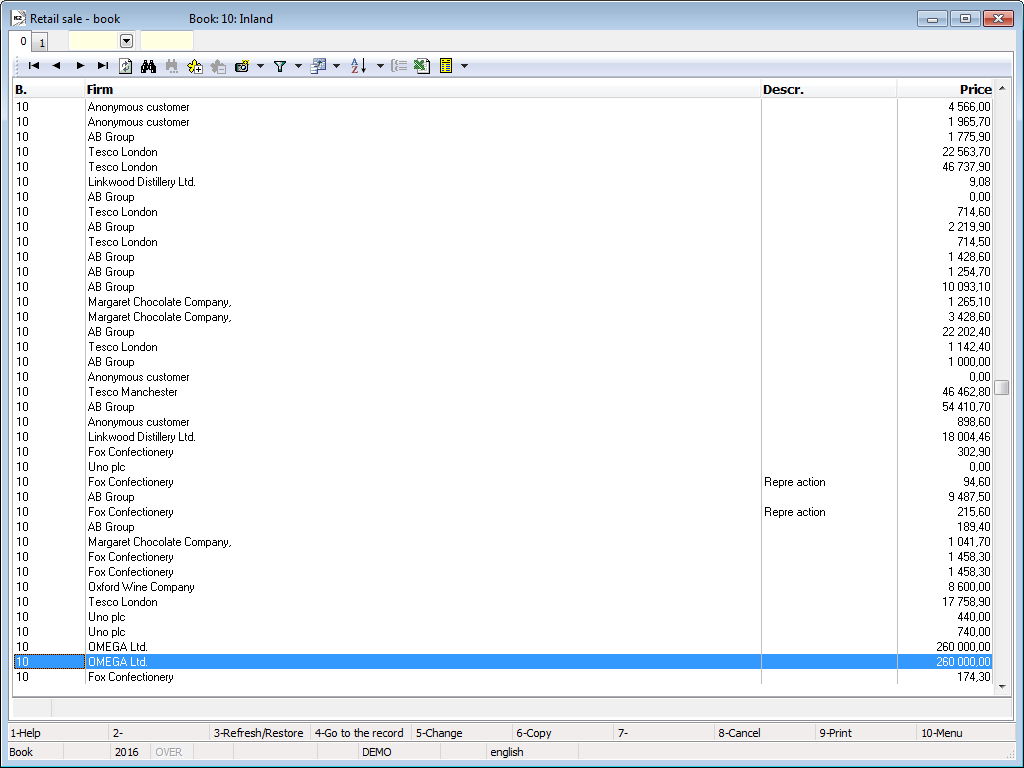
Picture: Retail sale - Book
You create a new business case by Ins key.
The main form will be displayed after pressing Ins key: Retail Sale - basic data.

Picture: New Sales Order created by Retail Sale
The Customer card, which is set by Customer parameter, is automatically inserted to the Sales order. Payment method and the value of this field from the selected card is further displayed next to this field. The displayed text serves only for orientation, whether you can only invoice the sold goods to this customer or whether a customer has to pay on the spot. This control will be specifically described in the description of the Payment form. If the selected customer has already exceeded the allowed credit, this information will also be appeared at the top of this form.
After the possible selection of a customer, you can start to enter the items. Enter Abbreviation of article / EAN into the Abbreviation / EAN field (in dependence on the VyhledavatZkratku parameter). If the article was not recognized, book of Article or a message, that the article was not found, will be displayed in dependence on the ZobrazovatLookUp (DisplayLookUp) parameter. After successfully entering the article, a selling price will be automatically loaded (reflecting the price group and the other elements of pricing) and the unit related to the loaded bar code, or a default sale unit. If none of these units is set on the card, the basic stock unit is loaded. Fill in the other fields (Quantity, Price, Discount/UM). After confirmation of the value in the Discount field, an item is created. It will be displayed below in the list of items and the form is ready to enter other item. The field, after which the item is finished and a new item is entering, can be set by the PosledniPole (LastField) parameter. So, you can continue in entering other item.
The summing data per document, that means Total incl. VAT, Total excl. VAT and Number of items, are displayed in the left part of a form.
If the entered article is not in a stock, there is a red box around the Quantity field. In this case not a release note but a reserving card will be created (if the NevytvaretRezList parameter doesn't prohibit it). If a selling price is not define on the Article card or if the price is zero, there is a frame around the Price/UM field.
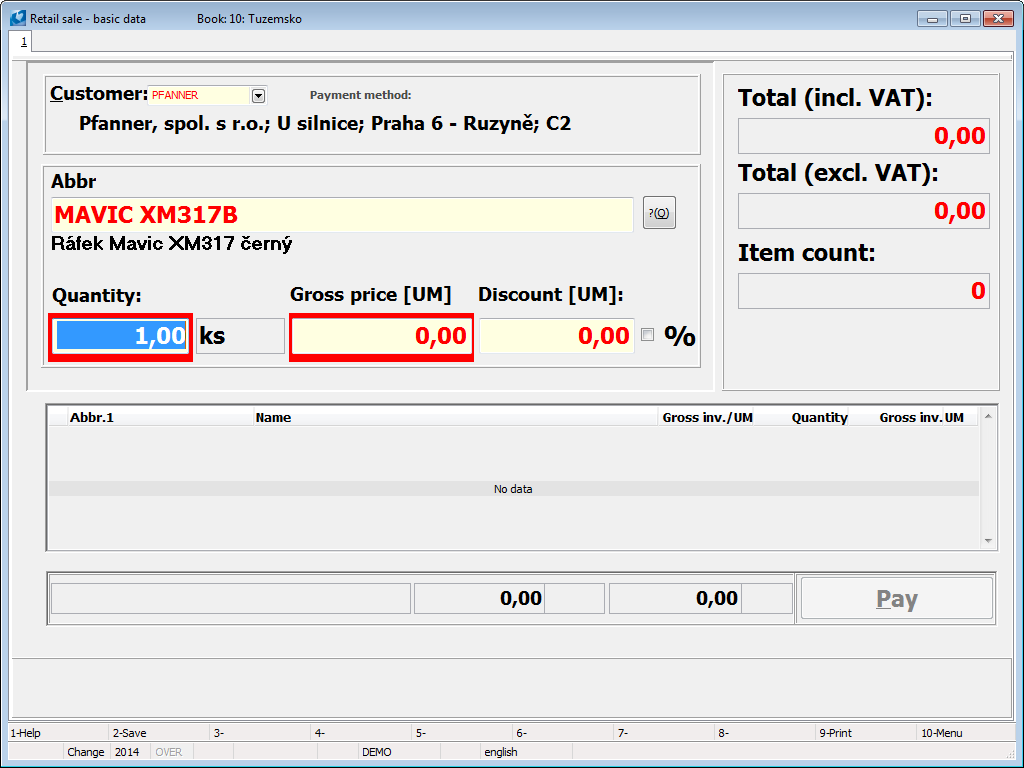
Picture: Credit exceeded, not in a stock, zero price
In a list of items, it is possible to choose the current item in dependence on the settings of the ZmenaPolozky parameter and display a standard Sale item form, in which it is possible to change the required values in dependence on the user rights, by double click or by Enter key. The basic information about the item marked by a light indicator can be also seen under the list of the items. If the light indicator is not active, (e.g. if you are entering a new item at the moment), the information about the last entered item are displayed here.
If at least one item exists in a processed sales order, the button Pay becomes active. By this button you can finish the entering of items and move to concluded or payment of a sales order.
By pressing the button Pay on a semi-finished sales order you can the sales order finish and pay through Payment form.
If you want to bill a sales order, customer will settle it us (e.g. by bank transfer). You choose Payment method Bill in lower part of the form. It is possible only:
- Customer on his card has set Payment method, which is included in a list determined by the parameter PlatbaFakturovat.
- The credit of a customer was not exceeded (see the main form ???) and neither the credit will be exceeded by this sales order.
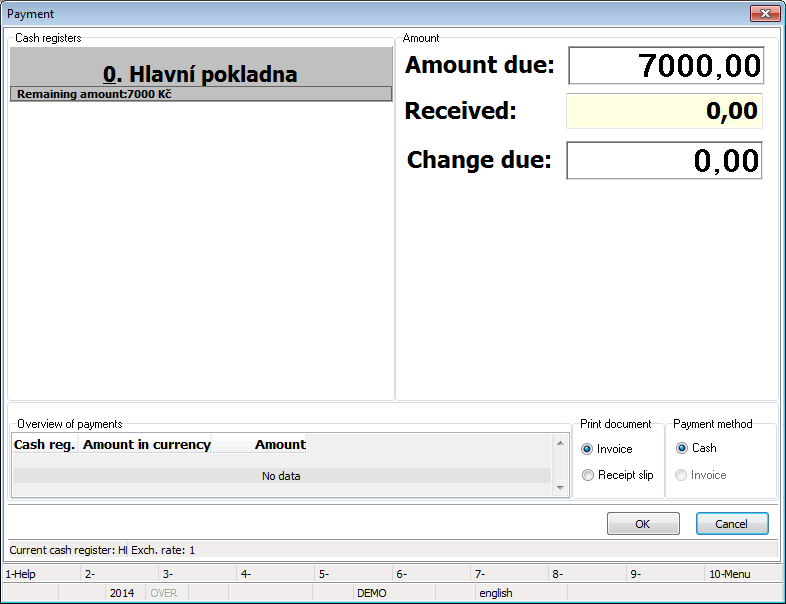
Picture: Retail - later settlement by e. g. By transfer
During the billing the field Paid doesn't fill. It isn't possible to print a receipt slip, you can print only an invoice.
If you want to gain money to a sales order now, you will choose payment method in Cash in the right part of the form. Every time this option is available.
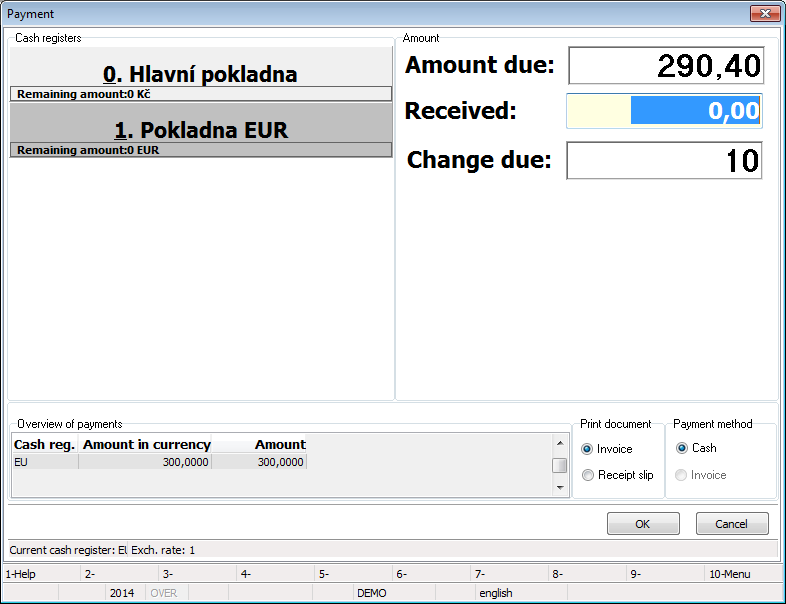
Picture: Retail - Payment with payment method "in Cash"
In the left part of the form in this case a list of the cash registers displays, by which you can pay according to a settings of the parameters Cash register 1-7. In the picture a default cash register i kept in the parameter Pokladna1, the parameter Pokladna2 is set on the value 'SP' (it is Cheque cash register). One of the buttons is always highlighted (darker colour). By this cash register you will settle entered payment. During the every new activating the form a cash, which is set by the parameter VychoziPokladna, is always highlighted. In the picture the Cheque cash register is set as default (it is value of parameter = '1').
Inside of the button an amount is display which will be paid by appropriate cash register. If it is e. g. a cash register for foreign currency, an amount in this currency will display here. In the button entered amount is managed by rounding according to the setting rounding in Payment method described in the chapter Rounding off Inland Invoices according to the Payment Method, which is set on appropriate cash register by the parameters ZpusobPlatbyPokladna1 - 7. If it isn't set, rounding will apply from the Client parameters, where Payment method of last entered payment will set to the document.
Total amount of the document is display in the right part of the form in the field Price to pay. You enter accepted value to the field Paid, which will be counted to highlighted cash register, where you can combine the cash registers. When a sum of entered payments is higher than total price, difference will display in the field Repay. That means amount which will be returned to a customer.
If you keep '0' in the field Paid (as it is in the picture) and then you press Ctrl+Enter keys, F11 key or the button OK by mouse, an exact amount will automatically paid/ paid off which will be paid by currently set cash register. Correspondingly a script preserves in case you have to return to customer - returned amount will be automatically deducted from default cash register. In this case a payment method will set to a document set by the parameter PlatbaHotove.
Overview of the entered payments is displayed in the left part of the form. Paid amount and cash register by which the payment was executed is apparent here. Other entered payments attribute to the same cash register.
Method of VAT calculation from above in the IS K2
VAT Law enables to calculate amount of VAT from below that from a price without the tax you determine amount of the tax by the percent. Price with the tax is a sum of these two amounts. It is also possible to calculate amount of the tax from above that a total sum with tax is multiplied by four-digit coefficient. This calculated and rounded tax is deducted from the total sum. By this difference the price without the tax is calculated.
In this chapter will be seen how you have to set and use the VAT calculation from above in the IS K2. Methodology is determined especially for retail trade where in exceptional situations during the calculation from below could be created the differences between the price with the tax entered stated in the item and the price with the tax counting to a header of a document. Perhaps more interesting is in a situation when a price of a sales order is determined by a final contract price (for example arranging work... 46 GBP).
Methodology is based on the flags, the set rounding and modified calculation of a tax recapitulation. It is used only in the Sale. From it's using an order of restrictions results. For example it isn't possible to match the documents with a various method of VAT calculation or to create the multi/documents from its. In the document item with the VAT calculation from above flag it isn't possible to edit a price without the tax and you cannot enter absolute discount (only percent). You cannot manually edit the tax recapitulation with this method too. Method of calculation is verified during the creating a copy of the document too.
Settings in the books of sale
You apply a whole methodology for the book of sale which you choose.

Picture: Setting the method of VAT calculation from above
In a newly created book 50 check the flag Calc. of VAT from above. This flag is automatically set to all the periods of the same book and flag's value copies to all the newly created superior documents and the free documents of the sale by the copy of the other document too (F6) - in this case the tax recapitulation automatically recalculated according to the currently set method in the appropriate book of sale. To the bounded inferior documents the flag always copies from the superior document. If the book is changed during the creating a copy of the document too and by thus the flag of VAT calculation method is changed, the user will be warned on it and he could choose if he want to recalculate the tax recapitulation according to the method of the current selected book or if he want to return back the change.
Flag Calc. of VAT from above on the individual documents you cannot change, it is only displayed.
Setting rounding in the Client parameters
In the Client parameters (described in the Basic guide of IS K2) for this method of calculation you set rounding in the column Gross.
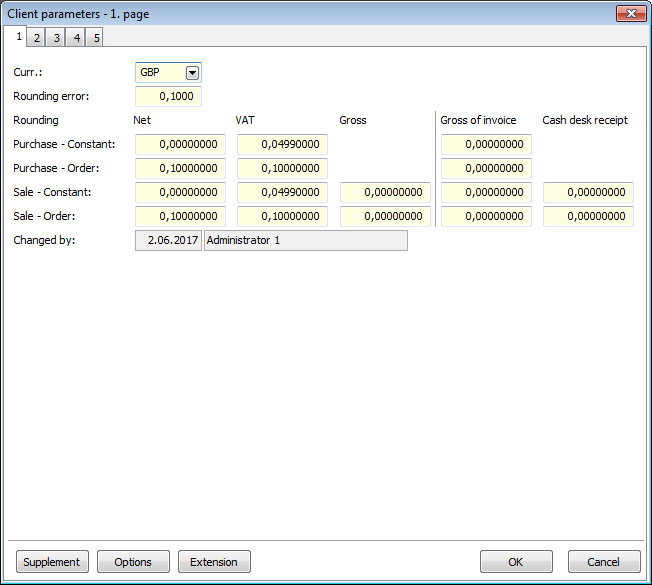
Picture: Setting rounding in the Client parameters
Setting determines how a price with the tax will round in the individual rows of the tax recapitulation. But set rounding the VAT amount will apply in the column VAT too - the VAT law sets the options. If you have got more tax types on the same document, it is recommended to choose rather a finer rounding cause this settings influences each row. If you choose for example the whole pounds, in a document with the three various tax types may be rounding difference almost to 1.50 GBP against the sum of the individual items.
Note: It is needed to strictly distinguish in the column Gross and in the following column Gross of invoice. The first column rounds the rows of the tax recapitulation, as already mentioned. While the column Gross of invoice influences a final amount of the invoice. Methodically it isn't recommended to use this option of rounding cause by its using may occur to the tax evasions the influence of that the final amount will be rounded up and it won't correspond to the sum of the amounts Net+VAT. Instead of that it is recommended to use the option of rounding the invoice according to the payment method by which the appropriate methodology deals with it. This option results follow braking up of the difference against the original amount from the other values and thus it is in accordance with the VAT law.
Settings of the constant for the VAT rates
For using the method you need to enter the constants according which the tax will be count. The constants, resp. the number of it's the decimal points is stated by the law. You set the constants is in the code list VAT rates.
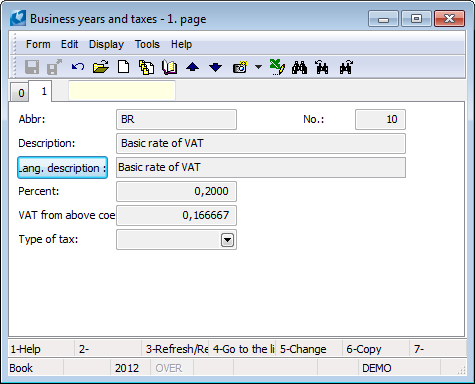
Picture: Settings of a coefficient for a calculation of VAT from above
Tax Calculation and Recapitulation in Sales Documents
Example: The customer AB Group wants to buy the bicycle APACHE TOTEM 06 per unit price 1,900.595 GBP Gross. As always, he will pay by transfer (no rounding off is set on this payment method). The article will be bought in a store, thus you will use a book with the checked VAT from above flag.
Create new Sales Order and insert an item in it. If it is necessary, edit a price. If the VAT from above checkbox is set, then it is not possible to edit the price Net. It is assumed that the final price is always specified in this cases.
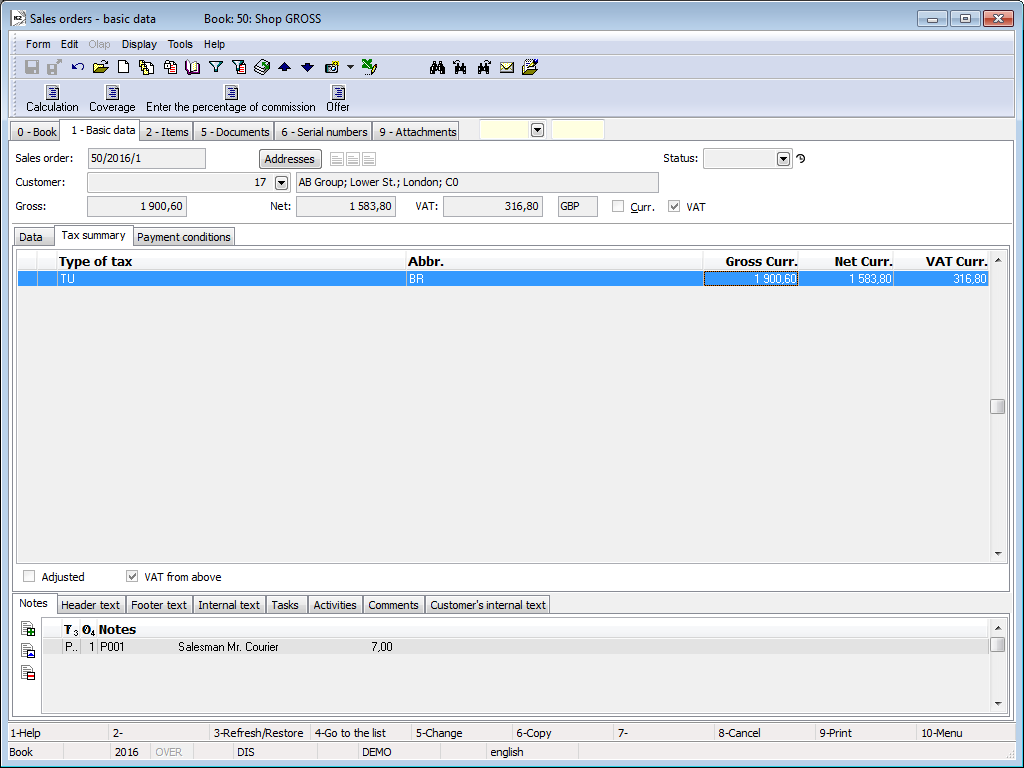
Picture: The created Sales Order with only one item in the value of 1,900.595 GBP
Browse the Tax summary overview on the Tax summary tab. There is also evident the flag, that the method of VAT from above is used in this document, here (down). This flag is loaded and saved from the Book of sale when creating the document and it is only displayed. It is not possible to change it in the document even when you change the setting in the Book of sale.
Calculation of the individual values of the tax recapitulation in the method of VAT from above is as follows:
- Total Gross amounts will be loaded from the individual items according to the Tax type set in them whereas one new row will be created for each Tax type used in the document.
- A row with the basic rate will be created: BR.
- So counted Gross value will be rounded according to the setting of the rounding constant and the order in the Client parameters for Gross.
- In BR row, the value 1,900.60 GBP will be loaded into the Gross Curr. column.
- The VAT amount will be counted from this amount according to the coefficient set for the appropriate rate.
- In our case it is 20% tax rate, thus 0.1667. The amount 316.82918 GBP is calculated.
- The resulting tax will be rounded according to the setting of the rounding constant and the order in the Client parameters for VAT.
- VAT amount in BR row will be rounded to 316.80 GBP.
- Then the amount excluding VAT will be counted as a differential (Gross - VAT). The amount is not rounded any more, because it is based on the values that are rounded according to the our needs.
- (1,900.60 - 316.80) = 1,583.80 GBP will be counted in the Net column.
Now you can see the difference in the results of the both methods of VAT calculation. Display the Sales item form and display the Net prices (by using the Prices button).
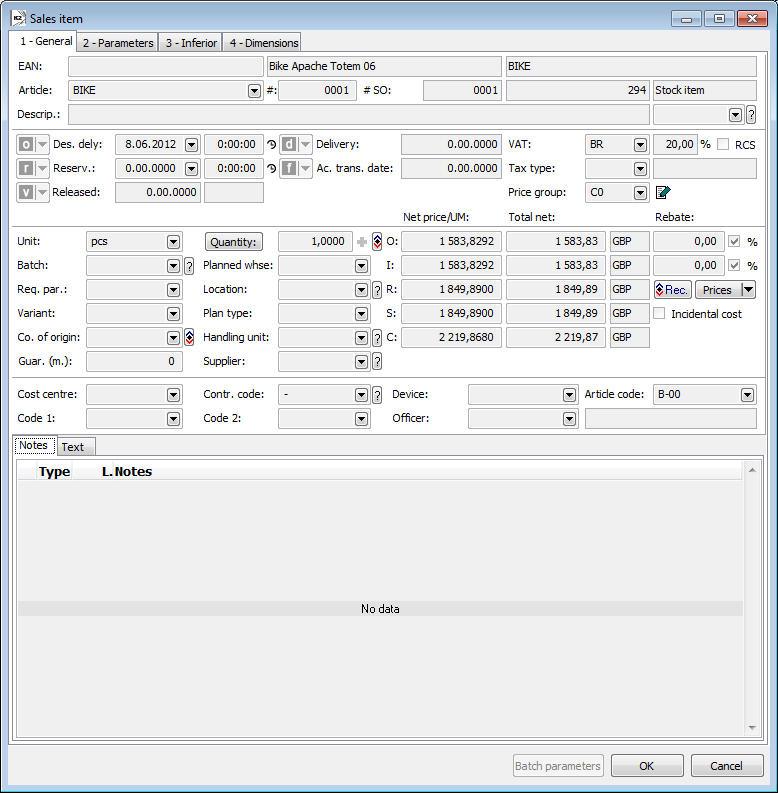
Picture: Sales item from a sales order with the calculation VAT from above
Price from the Articles card is maintained in an item. The price excluding VAT is defined here by the exact part as during the VAT calculation from above. Actually, the both methods of the calculation differ precisely in the fact, which amount is regarded as default.
Note: When creating and after-printing of the Invoice Out or Retail Sale in cash reports, the calculated fields, which are different from the real items of document such that Net/UM in items corresponds to the amount in a Tax summary, are displayed in items. The documents with the method of VAT from above are also posted according to the similar item calculated fields.
Note: There is obvious next restriction of this method of the VAT calculation in the picture - the Net price cannot be changed and it is not possible to enter an absolute discount (the flag % is grey), it is only possible to specify a percentage discount.
Commission
Commissions enable to user IS K2 to manage information about business activity based on trading by sales representatives. To individual customers you can assign sales representative and define percent of commission. Percent of commission will responsible to appropriate sales representative if he make a deal with customer. You can display the invoices with commission per defined period or per selected sale representatives including extent of their financial reward too.
Commission - Example
Example described in the followed capitols clearly shows the particulars phases of commission processing. At first you must enter the commissions on Suppl./Cust. card. In the second part a variant which describes when you have to pay off commission after issuing an invoice regardless if an invoice is paid off and in which extent is paid it by customer. Other variant is a depending the payment of commission on amount which was settled for an invoice. This option is described in next capitol. Example is closed by detail explanation of Process commissions form and by option of print Overview of recognized commissions.
Example: To sales representative P003 (Ing. Karel Nový) you assign a customer Demo s.r.o. From every negotiated deal a customer will be entitled on 5% of commissions.
Procedure of solution:
- On the card of a selected customer you activate the function Commission (the script Enter the percentage of commission - PROVIZEPROC.PAS), which will create a note of the type 'PP' for an appropriate customer. You define data for a commission to the form.
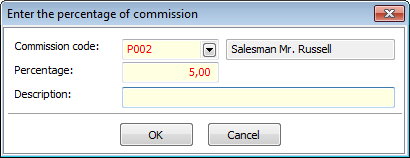
Picture: Enter the percentage of commission
Fields Description:
Commission code |
From the menu you choose a sales representative which will be set an appropriate customer in competence. Alternatively you click the field and you create a new sale representative by Ins key. |
Percentage |
The amount of commission in percent. |
Description |
Brief commission description. |
- After pressing the button OK a note with the type 'PP' will add to the Suppl./Cust. card.
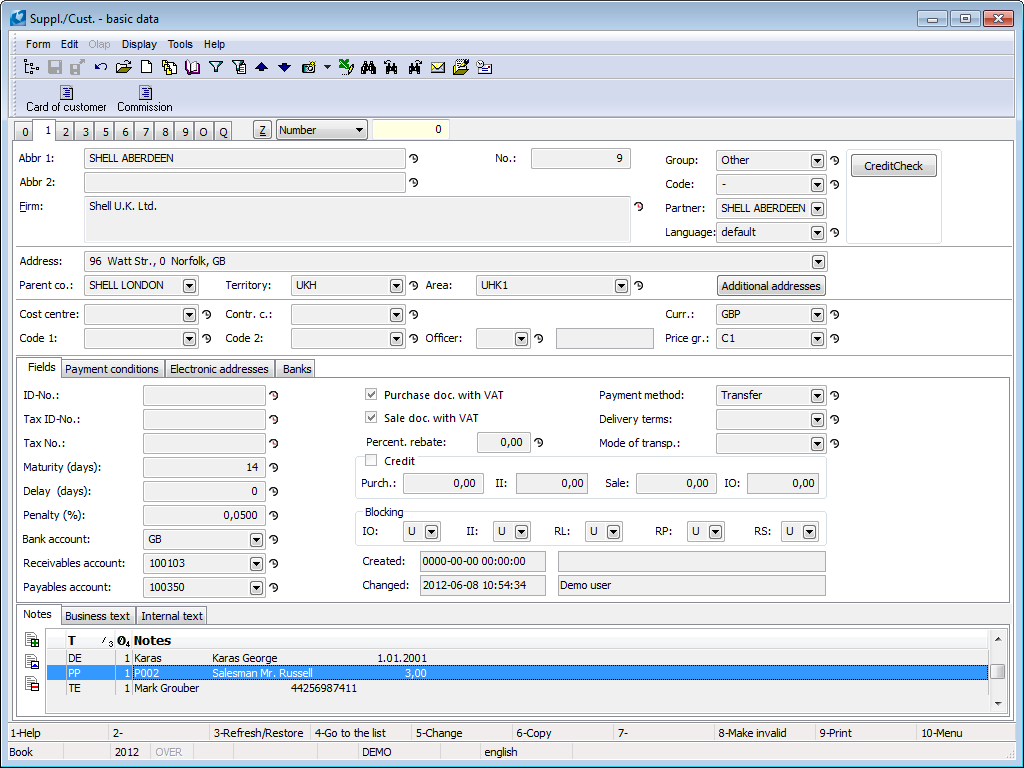
Picture: Adding a note with the type 'PP'
Note: If you want to transfer a record right to the note, you will save ID of this group (value of the field Cis) to a parameter of the script described above. Who has got a right on the record can activate script with this set parameter.
- In the Sale module you issue a sale order in the amount 100000 GBP. During the saving a sales order on the 1st page a note for commission is inserted.
- You issue an invoice to a customer. During the saving an invoice by the pressing F2 key or a confirming a note from a sales order is copied to the created invoice.
- Function Filter of invoices with commission - FILTRPROVIZE.PAS activated over the Invoices Out book serves for a filtering the invoices with the commissions according to the period that we selected. After checking the field Commission code you can specify a sales representative to which the invoices well be related. Unchecked of the field filters the invoices which are related to all the sales representatives.
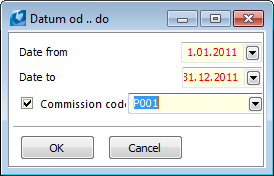
Picture: Opened form of the function Filter of invoices with commission
- After pressing the button OK and switching to the Filter On state the invoices with the commissions will filter to this filter.
- By activating the Seznam faktur vydaných dle provize report (List of invoices out according to commission) you display the appropriate invoices. In the column Commission the amount that belongs to an appropriate sales order from an appropriate invoice. In our case it will be 5 % from 100 000,- GBP.
Note: The commissions are always copied from a previous year. If a note isn't stated in a previous year, this step will be skipped. That means if the note with the type 'PP' isn't in the invoice, during the activating the function Commission the note will be automatically loaded from a sales order. If the note isn't there either, the note will be filled from the customer. If a commission isn't filled at customer either, an empty form will open.
Note 2: If more notes PP exist on a source record, the only one found will be processed to the documents.
The exclusion of a commission from some sale item:
If you enter a note with a commission code '-' and with some rate (0%) to the Article card or to a sale item, the turnover of this article will count by entered percent (0%). There are cases of for example a delivery, the advances etc. for which you don't attribute the commissions to the dealers.
Theme of the user editing:
On the Article card you can enter a note with a commission code of the various sales representatives or on a sales item you add a note of an appropriate sales representative but with a different rate then it is in header. In this case the item will be count with another selected rate. We can influence the various rates of the commissions for the various kinds of a range and even in relation to the various sales representatives. But this variant standard isn't treated.

Picture: List of invoices out according to commission report
Example: You evaluate the claims on the commissions 1 per month. Mr. Nový can claim a commission for an issued invoice for the Demo company in amount 5 % from 100 000,- GBP. To the system you want to note you recognize commission in April 2007 in full amount (or 5 000,- GBP).
Procedure of solution:
At the end of the month you run the function Acknowledge commissions. In an introductory form you fill a period to which an invoice has to be involved to the invoice will be evaluated. For example if it is determined by internal methodology the commission isn't acknowledged when the invoice is older than 1 year, you will reduce a selection of the invoice in this form.

Picture: Selection of a time interval for the evaluating
To the form that is displayed after entering time interval all the confirmed invoices will loaded. Invoice date of the invoices is included to the selected interval (in case of evaluating regardless of the payments).
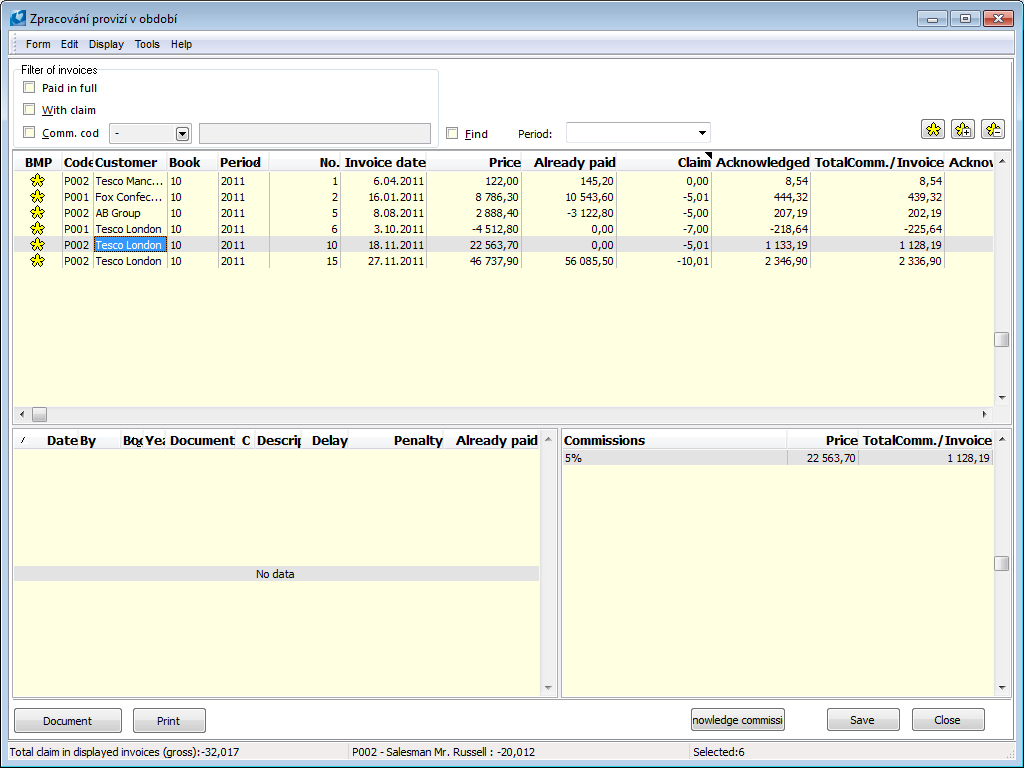
Picture: Acknowledge commissions form
In upper part of the form you can see overview of the invoices correspondingly of the input conditions and the selected check boxes. Only the marked invoices will be accepted. You can use the buttons in the right part for a marking.
In the lower part on the left side the payments of an invoice, where the light indicator is in the upper part, are stated. On the right side an overview (how the amount was specified) is displayed for the same invoice.
The button Document display preview on an invoice where the light indicator is. The button Print prints report Acknowledged commissions - description is below. The button Acknowledge commissions prepare saving a note with the type 'PU' where information about amount of acknowledged commission, period of Acknowledge commissions and date of acknowledgment is saved. Together according to acknowledged commissions the values in the upper part of the form is adjusted. By the button Save above stated notes will create in the IS K2. If the result of acknowledge commission doesn't like you, you could close form by the button Close without saving the changes. The notes won't save in IS K2 and during the recurrence running the function everything will be in original state.
In the last row you can see sum of all the commissions on the displayed marked invoices. I.e. if you acknowledge the commissions now, how many conditions would be acknowledged. The second detail displays the same detail only for a sales representative from an invoice where the light indicator is. In the last field the information about number of the marked invoices is displayed.
Description of the selected fields and the columns of the upper part of the form:
Paid in null |
Only fully paid invoices will display. You can preset the check box by the parameter chbPaidInFull. |
With claim |
It displays only invoices on which a claim is count in absolute value higher than value of the parameter MinClaim (implicitly 0.499999). You can preset the check box With Claim by the parameter chbWithClaim. |
Commission code |
By the checking the check box you access an option of one commission code. After selecting the code only the invoices relating to only appropriate sales order will display. You can preset the check box by the parameter chbCommissionCode. |
Find |
Checking the check box enables you find and show the previously acknowledged commissions. From the menu you choose a period to which the commissions have to be acknowledged. After selecting only the invoices to which the commission was acknowledged in selected period in arbitrary amount will display. |
Price (Brutto) |
Price (Brutto) of invoice. Display of the columns depends on if the commission counts from net price of the invoice or gross price of the invoice. This is set by the parameter Brutto. |
Already paid |
Amount of invoices payment. |
Claim |
Calculated value according to the settings of the functions parameters. It is possible to edit it manually by pressing the Enter key, by entering a required value and re-confirming by Enter key. |
Acknowledged |
How many have been previously acknowledged in the commissions per an appropriation invoice (possibly after acknowledgement and before saving). |
Acknowledged in period |
How many have been acknowledged in the commissions in a period for which a searching is on. If the searching isn't checked, this column will be every zero. |
TotalComm./Invoice |
It displays a maximum value that has to be paid off per an invoice. Claim is calculated as a Total commission - Acknowledged. |
Example: You evaluate the claims on the commissions 1 per month. You issued a new sales order (and an invoice) for the company Demo on the net value 100 000,- GBP, from which 70 000,- GBP (83 300,- GBP) was settled by the company. Mr. Novy can claim 70 % of the total commission on this invoice. During the evaluating you acknowledge 3 500,- GBP and then you can see a dealer will get else 1 500,- GBP per this invoice after paying off the invoice of the customer.
Procedure of solution:
You issue a new sales order and an invoice on 100 000,- GBP for the company Demo. To the invoice a note with the type 'PP', with a sales representative 003 a with the amount of a commission 5 % will enter from the previous settings. Further to the tree or to F9 menu you sort the script Acknowledge commission with the parameter Payments set on Yes. You run the script. Start window will open with a selection of the interval from which the invoices will be evaluated. In case that the parameter Payments will be on, all the confirmed invoices with the note with the type 'PP' are processed at which at least the one payment was executed in the selected interval. Selection of the invoices you can reduce by the check boxes in the upper part of the form. These check boxes are described above with the other buttons and the columns.

Picture: The invoices corresponding with the conditions for acknowledge commission
To the field Period you fill in a period for which you process the commissions. In our case it is June 2007. If you processed a part of the commissions for this period earlier, you could choose name of the period from the offered code list. You keep all the invoices as marked at which you want to acknowledge a commission. Amount of the commission you manually edit - you select an appropriate value, press the Enter key, write a required value and confirm by the Enter key. For induction of the changes you press the button Acknowledge commission. The report, how many commissions will be acknowledged, will display. In the picture was checked (the check box With claim) that you want to see only the invoices on which isn't a zero claim (resp. claim is smaller than the value of the parameter MinClaim). Therefore all the marked invoices disappeared after acknowledgement. After cancelling the check box the disappeared invoices will appear again together with the other invoices that corresponding to the initial conditions.
Attention: The notes about acknowledge commission ('PU') will be created after pressing the button Save. If the form is closed without saving, all processing will be lost!
Example: You want to see overview of all the invoices to which you acknowledged a commission to the period June 2007. You also want to print a document to the sales representatives, on the basis of which the sales representatives can bill the claimed commissions.
Procedure of solution:
After processing the commissions per a certain period you need to print an overview about how many totally and to which the sales representatives you have to pay out on the commissions. You run the script Acknowledge a commission, in the starting form you keep the complete interval of display. Then you check the check box Find and you choose the required period - in our case June 2007. All the invoices are displayed to which the commission was acknowledged in the selected period. In this case a detail about amount of the acknowledged commission in the selected period displays in the column Acknowledged in period. The amount may differ from the aggregate amount Acknowledged, because a part of the commission per certain invoice could be previously acknowledged, resp. except the searched period.

Picture: The searched invoices processed in the period June 2007
You can print this overview by pressing the button Print. The report you can activate only from the script and after the saving all the changes.
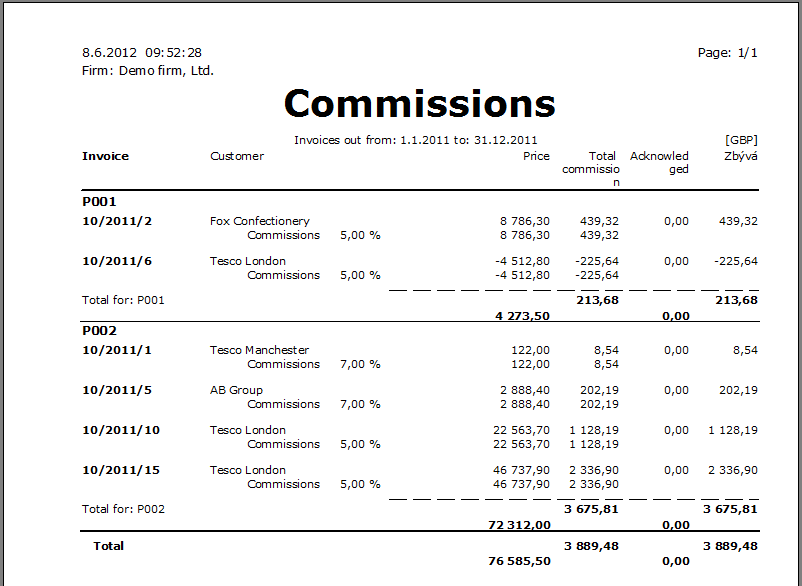
Picture: The report Commissions per period
If you want to print the overview only for one sales representative, before running the report you will check the check box Commission code and you select a required sales representative.
If you activate the same report (by the same button) in case that the check box Find isn't checked, then the report (after the saving again) will print contain of the form, i.e. the invoices which are displayed at the moment.
Technical solution
List of the files:
|
||
|
RF_Provize.pas |
Script is called by the registered functions through the RF_K2STD.PAS script, which uses the U_RF_K2.PAS unit. In the unit, the calling is defined as follows:
It is necessary to permit the registered script in the administration of registered scripts. |
|
Provize_main.pas |
The Acknowledge commissions script determined for the processing of commissions. |
|
Provize_form.pas |
The auxiliary script to the Provize_main.pas script. |
|
ProvizeProc.pas |
Script for the inserting the note of the 'PP' type on the Customer card (number of the form of the note = 01006). |
|
FiltrProvize.pas |
Script for the filtering the invoices out with the note of the 'PP' type. |
|
U_provize_konst, U_provize_období |
The auxiliary units to the Provize_main.pas script. |
|
||
|
||
|
VF_Provize.am |
The List of invoices by commission print report. |
|
F_Provize.am |
The Acknowledged commissions print report executable only by the button from the Acknowledge commissions script. |
|
||
|
||
|
DateOdDoKod.txt |
Form to the FiltrProvize.pas script. |
|
FProvize.txt |
Form to the ProvizeProc.pas script. |
|
Provize_form.dfm |
Form to the Provize_Main.pas script. |